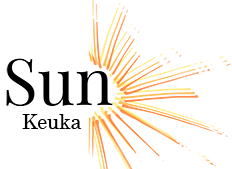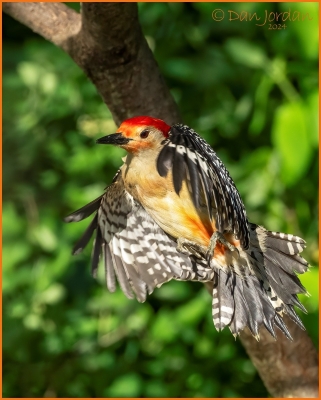Meet our local population: Red-headed or Red-bellied? Flickers, Pileated, and more!!
By Dan Jordan, pictured is a male Red-bellied woodpecker in flight
Have you heard? Bird is the word! Of course, this is a reference to the lyrics of a song from 1963 called Surfin’ Bird, by the Trashmen. Peter Griffin from Family Guy (Season 7) probably made the lyric more famous than the original with his quirky repetitive rendition of the “Bird, Bird, Bird, Bird is the Word” lyric. Anyways, in this series of articles, Bird [really is] the Word!
I have become a wildlife photographer in my retirement years. I travel extensively to find wildlife, but most of my encounters and the resulting images are from right here in our local area.
In the Eighth installment of this series, published last week, I shared images and discussed orioles and the numerous encounters I’ve had right in my front lawn. This week, my focus shifts to other local species that visit my home in numbers. Specifically, woodpecker species will be the feature of this week’s installment.
This first image is one I captured from my front porch of a male, red-bellied woodpecker in flight.

Many people see the red heads of this species and draw the conclusion that they are red-headed woodpeckers. Their namesake red bellies aren’t prominently displayed most of the time. I chose this image to show first, because it does show the ‘belly feathers’. There are red-headed woodpeckers around here, but they are rarely seen. I, for instance, have never seen one within 150 miles of our area. The image below shows what a red-headed woodpecker looks like. This image was captured at Blackwater National Wildlife Refuge in Maryland in 2024. There is quite a difference between the red-headed and red-bellied species. (note that the red-headed WP’s do not have any red on their bellies!)
Back to the local, red-bellied woodpeckers, we have two pairs that frequent our feeders and our ‘woodpecker tree’ (a dead tree that the woodpeckers and nuthatches use to cache nuts and seeds in). Each year, they bring their young to the tree to feed them and to teach them in the finer art of ‘pecking’ and food caching. This next image is of a female RBWP feeding a nut to its fledgling.

Here’s one last image of a RBWP, this one of a pair (mates) feeding on a seed cake at the same time. (Female front, male rear)

Since we have two local pairs of RBWP’s, it is not uncommon to see as many as three at our home. I have never seen all 4 there at once, but I’m sure it has happened. When the young fledge, there may be even more present at the same time.
Red-bellied woodpeckers are large birds, but do not compare to their cousins, the pileated woodpeckers. I’ve only seen PWP’s at our home maybe a half dozen times and only photographed them twice (see following image for one of a female PWP on our woodpecker tree).

I do see pileated woodpeckers on my travels but not very often. They are very skittish around people and vehicles, so are difficult photographic subjects.

Did you know that Woody Woodpecker, created in 1940 by Walter Lantz and the property of Universal Studios, was modeled after a pileated woodpecker. In this next image, captured near Naples, NY last year, I have added a small insert of ‘Woody’ for comparison to the male pileated in the image. Other than the orange beak, there is a remarkable resemblance.

Pileated woodpeckers are huge. They stand roughly 17 inches tall and have wingspans of as much as 30 inches. When you see one, you’ll know you saw one!
The next local woodpecker to discuss is the hairy woodpecker. Slightly smaller than the RBWP, the hairy WP is much larger than its look-alike, the downy woodpecker. Many people confuse the hairy and downy species because the look remarkably similar, that is until they see them side by side. This next image is of a male, HWP chasing off a female, RBWP from the woodpecker tree.

Here’s another image of a male, HWP, perched in one of our trees. I don’t get a lot of perched images of any of the woodpecker species. They are so active, between grabbing a seed or nut from a feeder, seedcake, or suet then flying off to feed young or cache the morsel, they don’t sit still for long.
Note that there is nothing wrong with the woodpecker’s eye in this image. Birds have a membrane, called the nictitating membrane which they can swipe horizontally across their eye to clean or protect it. I just happened to capture this image during an ‘eye cleaning’ moment.

The next species of woodpecker is the aforementioned downy woodpecker. Downy’s look very much like the hairy’s but are much smaller! The easiest way to tell the two species apart, other than the obvious size difference, is their beak length. DWP’s have much shorter beak to head size ratio than their larger cousins. Here’s another of those ‘rare’ perched shots, this one of a female, DWP. Note the tiny beak (as a ratio to its head size).

In both the DWP and HWP species, red feathers on the back of their heads denote the male of the species.
My last woodpecker to share is arguably my favorite. The northern flicker in our area is called the yellow-shafted northern flicker. West of the Mississippi (or thereabouts), the same species is known as the red-shafted northern flicker. The shafts of their feathers are different colors despite being the same species. I have not quite figured out how that works yet, how it can be the same species. The following images are all the yellow-shafted variety of northern flickers. I do not yet have any images of the red-shafted birds yet, although I did see one in Utah in 2023. Capturing good images of RSNF’s is on my bucket list. I am driving to Yellowstone National Park this spring and hope to have the opportunity to photograph one or more.
The yellow color of the feather shafts and undersides are clearly seen in this image of a male, YSNF from our front lawn.

A very interesting thing about the northern flickers is that they, unlike most of their woodpecker cousins, tend to feed on the ground. They eat ants, and other crawling bugs and spiders and don’t spend much time ‘pecking’.
This next image is my all-time favorite of a northern flicker. I was lying on my belly, at eye-level of this male flicker for this shot. Note the big ‘honking’ beak.

The last image was captured in the Village of Allegany one day last year. As I drove down the street to the Post Office, I spotted this pair of flickers eating bugs in someone’s lawn near the sidewalk. That’s the male in the foreground and the female on the sidewalk. Their namesake yellow shafts don’t show much until they fly, then they are on full display. You can just see a hint of yellow on the male’s wing in this image.

I have images of other species of woodpeckers from my travels too. One very interesting species I have photographed is the acorn woodpecker. Look that one up on the internet (or inner web, if you will). There is a great story about them caching their food!
I hope you’ve enjoyed this brief walk-through woodpecker-land with me. These species are all found locally, so they’re out there for you do discover and learn about too!
I plan to submit more in this series of anecdotes about my local wildlife encounters in the future. If you have any questions or comments for me, or even suggestions, I can be reached at dan@jordanphotog.com. Thank you for your interest in my work.










